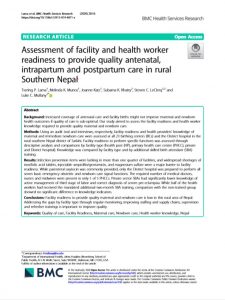
Background
Increased coverage of antenatal care and facility births might not improve maternal and newborn health outcomes if quality of care is sub-optimal. Our study aimed to assess the facility readiness and health worker knowledge required to provide quality maternal and newborn care.
Methods
Using an audit tool and interviews, respectively, facility readiness and health providers’ knowledge of maternal and immediate newborn care were assessed at all 23 birthing centers (BCs) and the District hospital in the rural southern Nepal district of Sarlahi. Facility readiness to perform specific functions was assessed through descriptive analysis and comparisons by facility type (health post (HP), primary health care center (PHCC), private and District hospital). Knowledge was compared by facility type and by additional skilled birth attendant (SBA) training.
Results
Infection prevention items were lacking in more than one quarter of facilities, and widespread shortages of iron/folic acid tablets, injectable ampicillin/gentamicin, and magnesium sulfate were a major barrier to facility readiness. While parenteral oxytocin was commonly provided, only the District hospital was prepared to perform all seven basic emergency obstetric and newborn care signal functions. The required number of medical doctors, nurses and midwives were present in only 1 of 5 PHCCs. Private sector SBAs had significantly lower knowledge of active management of third stage of labor and correct diagnosis of severe pre-eclampsia. While half of the health workers had received the mandated additional two-month SBA training, comparison with the non-trained group showed no significant difference in knowledge indicators.
Conclusions
Facility readiness to provide quality maternal and newborn care is low in this rural area of Nepal. Addressing the gaps by facility type through regular monitoring, improving staffing and supply chains, supervision and refresher trainings is important to improve quality.